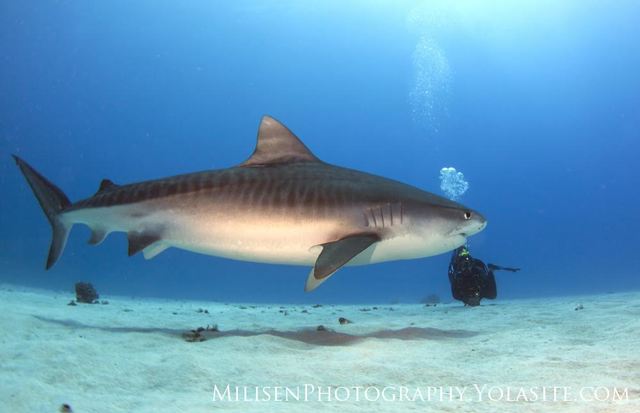KAILUA-KONA — A rising tide of shark bites off the Maui coast over the previous two decades appeared to indicate that sharks in the area had acquired a disturbing affinity for the taste of human flesh. ADVERTISING KAILUA-KONA — A
KAILUA-KONA — A rising tide of shark bites off the Maui coast over the previous two decades appeared to indicate that sharks in the area had acquired a disturbing affinity for the taste of human flesh.
“Over the past 20 years, Maui has had almost double the number of shark bites than any other island,” said Dr. Carl Meyer, Principal Investigator at the Hawaii Institute of Marine Biology.
The incidence of unwelcome, toothy savagery spiked between 2012 and 2014, when a total of 19 shark bites occurred, including eight bites in 2013 alone. Before 2012, there had never been more than three documented shark bites in one year stretching all the way back to 1980.
Concern and questions over the troubling marine trend was great enough that the Department of Land and Natural Resources commissioned a study to look into the matter.
“There was concern at the time that sharks were behaving differently on Maui,”said Dr. Bruce Anderson, the Administrator of the DLNR Division of Aquatic Resources. “We really had very little information at the time on why sharks were behaving the way they were, and really how they are behaving at all in this area.”
The Department of Health contributed roughly $186,000 to the study, Anderson said. The Pacific Islands Ocean Observing System, Ocean Tracking Network and Wildlife Computers also provided funding support. The study was conducted by the Hawaii Institute of Marine Biology and was headed up by Meyer.
Utilizing satellite tracking and acoustic tracking technology, Meyer and his team kept tabs for up to two years on 41 tiger sharks they tagged and captured around Maui and Oahu.
The most relevant information yielded involved the gently sloping insular shelf habitat, which was home to the majority of shark detections recorded. The habitat exists between the shoreline and the shelf break at a depth of around 600 feet. Meyer described the habitat as the highly productive home to a myriad organisms tiger sharks hunt as prey.
Maui Nui — or the greater Maui area including its three sister islands — has a greater area of insular shelf habitat than the rest of the Hawaiian Islands combined.
“It may well be that more foraging habitat means more sharks,” Meyer said.
The study also mapped home ranges for 19 tiger sharks, developing areas called core use areas where they spent most of their time. This mapping also produced telling results.
“Around Maui, there is a cluster of core use areas that is immediately adjacent to some of the high use, recreational ocean use sites for that island,” Meyer explained. “A combination of these two factors — the more extensive shelf area around Maui Nui and the concentration of core use areas close to recreational sites — could reasonably explain why Maui, over the last 20 years, had twice as many shark bites as other, main Hawaiian islands.”
From a scientific perspective, however, Meyer’s team was unable to rule out the possibility that differences in ocean use patterns might contribute to the incidence of shark bites near Maui as compared to other islands.
The study also looked at frequency of tiger shark visits to certain recreational ocean sites off Maui and Oahu. The tracking showed individual shark visits occurred at these sites an average of once every two weeks, and sharks lingered in the areas for roughly 12 minutes.
Data on some sites in Southwest Maui, such as Kalama and Makena Point, the presence of tiger sharks was detected on up to 80 percent of days monitored. Still, Meyer said that considering the thousands of daily swimmers, shark bites “remain rare events.”
He added that the pattern of bites on Maui, 70 percent of which occurred between 9 a.m. and 4 p.m., is driven more by human behavior than the other way around — in other words, being in the water when sharks are present.
Meyer said there are some seasonal patterns of shark migration. Studies indicate that tiger sharks from Oahu tend to frequent Maui waters during the core winter months, or prime mating season. This behavior was also attributed to the insular shelf habitat. Camera tracking showed tiger sharks engaging in telltale mating patterns in the area.
As for the influx of shark bites in Maui between 2012 and 2014 — 19 of them occurring during a three-year span — Meyer’s explanation was one of random statistical variation.
“From a strictly mathematic perspective, these are fundamentally low numbers, and chance variation is the best explanation for the presence of that spike,” Meyer said.
There were zero shark bites off Maui in 2011 and only one reported shark bite in 2015.
Meyer added the practice of shark culling, or the killing off of select portions of the shark population, will not curb shark bites.
“One other thing I want to stress is swimming in the ocean is swimming in what amounts to a wilderness type environment,” Anderson said. “Sharks are part of this environment, and we have to accept that they are there and take precautions to avoid encounters, which are going to occur from time to time. … That is a fact of life that is not going to change.”



